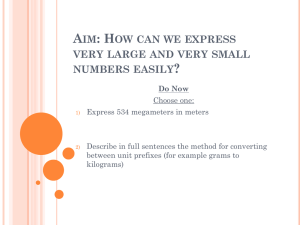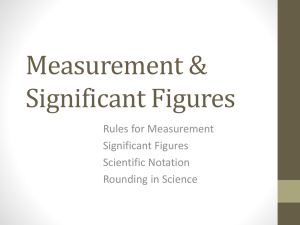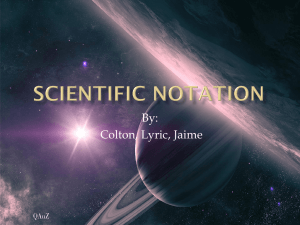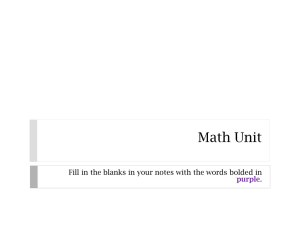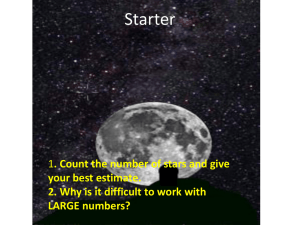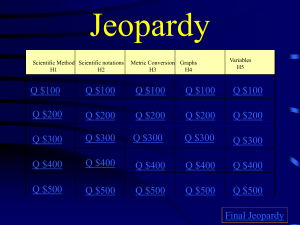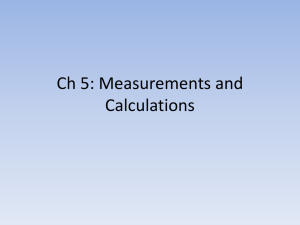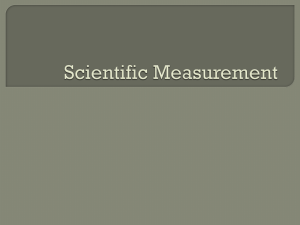Scientific Notation
advertisement
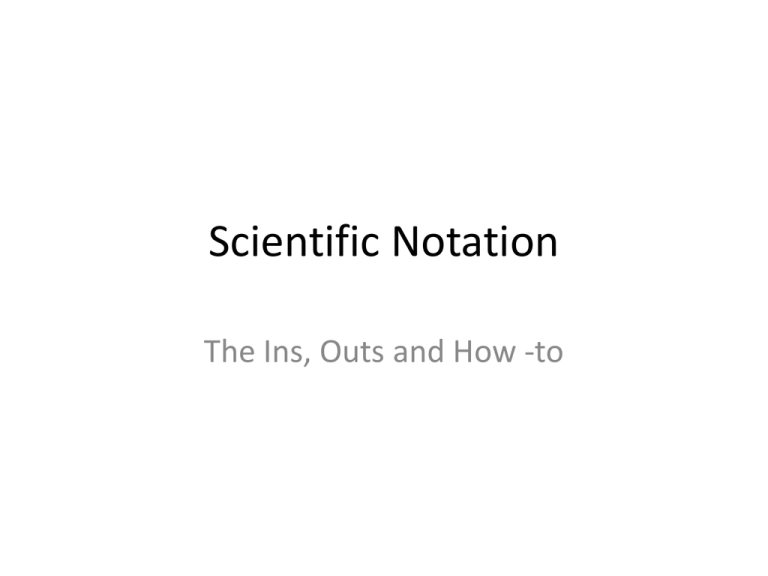
Scientific Notation The Ins, Outs and How -to Objectives • To express numbers in standard decimal notation and scientific notation • To convert numbers between scientific notation and standard notation • To explain the benefits of using scientific notation • To convert between scientific units • To develop undersatnding and basic examples of the Powers of Ten Benefits • Minimizes mistakes when using really large or small numbers in calculations • Saves time when writing really large or small numbers Example of Benefit Let’s suppose we had the technology to travel to the starts. You were trying to calculate how much fuel would be needed to get from here to Proxima Centauri, the nearest start other than our Sun. A mere 39,900,000,000,000 km away… Now if you had to enter that number into a calculator, what’s the likelihood you would miss or add a zero? Express the following in scientific notation: 39,900,000,000,000 km 1. Leave some space and write x 10 2. Locate the decimal point, move it so that you only have 1 digit to the left of it.* 3. Count the number of spaces you moved the decimal point and write it as an exponent with the 10** 1. _______ x10 2. 39,900,000,000,000 1. _______ x1013 Express the following in scientific notation: 39,900,000,000,000 km (cont) 4. Write the number that remains in the space you left. 5. If necessary round off so that there are only 2 digits to the right of the decimal point. 6. Don’t forget to rewrite the units!! 4. 3.99 x1013 5. (not necessary this time) 6. 3.99 x1013 km Just as an FYI Later in this presentation we will be converting between units but for now… Did you know that 39,900,000,000,000 km is the same as 271,000 AU (astronomical units). As you can see even that number has several zeros and would be better expresseed in scientific notation. For that reason, when we talk about the distances to the stars, we no longer use the AU; commonly, the light year is used. A light year is the distance light travels in one year - it is equal to 9.46 x 1012 km. Making the distance to Proxima Centauri a mere 4.22 light years. Practice Time Convert the following into Scientific Notation a. 247,800,000,000 L c. 0.0000000346 kg b. 987,000,000 mg d. 0.0001456 ms Answer Check a. 247,800,000,000 L = 2.48 x 1011 L c. 0.0000000346 kg = 3.46 x10-8 kg b. 987,000,000 mg = 9.87 x 10 8 mg d. 0.000000000001456 ms = 1.46 x10-12ms Opener • What benefit does writing numbers in scientific notation have? • Convert the following 1. 2. 3. 4. 346,000,000 s 0.00798 m -753,000 g -.0002156 N Express the following in Standard Notation 6.02 x1023 atoms (aka Avagadro’s Number) 1. Copy the decimal number 2. Move the decimal point the number of spaces indicated by the exponent* 3. Fill in empty places with zeros. 1. 6.02 2. 6.0200000000000000 0000000 Express the following in Standard Notation 6.02 x1023 atoms (aka Avagadro’s Number) (cont.) 3. Now remove the decimal point and add the commas (if necessary) 3. 602,000,000,000,000, 000,000,000 4. Don’t forget to rewrite the units 4. 602,000,000,000,000, 000,000,000 atoms Practice Time a. 5.87 x 10 4 km c. 5.39 x 10-2 cm a. 9.63 x 10- 7 kg d. 2.94 x 106 mL Answer Check a. 5.87 x 10 4 km = 58,700 km a. 9.63 x 10- 7 kg = 0.000000963 kg c. 5.39 x 10-2 cm = 0.0539 cm d. 2.94 x 106 mL = 2,940,000 mL Converting to and from different Scientific Units Now, that you have developed some proficiency with scientific notation the next step is to be able to convert from meters to kilometers or vice versa. Why would you want to do that? Just like when writing you choose words based on what best conveys your meaning. So it is similar with science units. For example: Which do you think is a better way of expressing this value: 1 km or 100,000 cm? True they are both the same BUT the first is a better expression of the measurement. So how do you do this… • One way is to memorize a chart and move your decimal accordingly. If you have learned that way great stick with it • Dimensional Analysis is a process where using a few basic relationships I can consistently get a correct answer. What is a “Base Unit?” • A Base Unit is a unit of measuring that does not have a prefix. • Examples: – Meter (m) – Gram (g) – Liter (L) – Second (s) • Not: km, mL, mg, etc Conversion Factors • SI Prefixes: pico = p = 10−12 nano = n* = 10−9 micro = μ* = 10−6 milli = m* = 10−3 centi = c* = 10−2 deci = d* = 10−1 kilo = k* = 103 mega = M* = 106 giga = G = 109 • (* = You need to know these commonly used prefixes and their abbreviations) • When setting up a conversion factor to or from a base unit, use 1 for the prefixed unit and the power of 10 for the base unit. • Examples: 1 mg = 10-3 g and 1 kg = 103 g. You will always be given the SI Prefixes & number values • Note: a conversion factor is always equal to the number 1 • Complete prefix Practice now to 550 mm, rest for HMWK Dimensional Analysis 1. Write the original number in scientific notation 2. Draw a railroad track. Write the original number in scientific notation in the first position (track) with the units. 3. Place the unit you are canceling in the bottom and the “new unit” on the top. One of these should be the base unit. Convert 4.7 kg to grams. • Solution : 4.7 kg g kg 4. Place the number 1 with the unit that has the prefix. • 5. Now you will use the chart to help you figure out the number to put with the “new unit” – Find the prefix on the chart – Write its number value with the base unit (the blank space) 4.7 kg 4.7 kg g 1 kg 103 g 1 kg 6. Multiply the tops x tops 7. If necessary multiply bottoms x bottoms 8. Divide top by the bottom 9. Write your final answer with units. Note to self.... Know your calculator... • “ee” on calculators means x10 • use parentheses 4.7 kg 103 g 1kg 4.7 x 103 g. Your Turn Convert 0.125 meters to mm. milli = m* = 10−3 becomes 1 mm = 10-3 m Convert 1,086 m to km kilo = k* = 103 Answer Check Convert 0.125 meters to mm. 0.125 m 1 mm 10-3 m = 125 mm = 1.25 x102 mm Convert 1,086 m to km 1,086 m = 1.086 km = 1.09 km 1 km 103m And now for the Advanced • These will be conversions between units when they both have prefixes! • Have no fear you already know how. It’s just going to take 2 steps to convert. • In other words, first convert to the base unit (meters, grams, seconds, or liters) then to the desired unit. Let’s Try One Together Convert 76 cm to mm. Let's try to convert this problem into two problems that we already know how to solve. First, look at the conversion factors we know involving cm and mm. • 1 cm = 1 x 10-2 m 1 mm = 1 x 10-3 m Both factors involve meters, which means we can convert cm to m, and then m to mm. In other words, this conversion will take two steps. Solution: First, convert 76 cm to m. 76 cm 10-2 m 1 cm = 0.76 m Next, convert 0.76 m to mm • 0.76 m 1 mm 10-3 m use your calculator = 760 mm Alternative Solution Solution: We could also perform this conversion in one equation by making one long train track. Those of you who eventually take Chemistry or Physics will work a lot of problems by stringing out conversion factors in this manner. Just make sure that the units cancel out appropriately. 76 cm 10-2 m 1 cm 1 mm 10-3 m = 760 mm A little Math Note • How do you multiply numbers in scientific notation? – Add the exponents! – (1 x 104) x (1 x 103) = 1 x 104+3 = 1x 107 • How do you divide numbers in scientific notation? – Subtract the exponents! (1 x 104) (1 x 103) = 1 x 104-3 = 1x101 Closer • What is scientific notation? • When will you use or have a negative exponent? • Do negative numbers have an exponent? Explain • What some benefits of scientific notation? Homework- due next class period Complete Prefix practice Homework 2* Basic Scientific Notation = 2 Conversions to or from a base unit = 3 Conversions when both units have prefixes =4

